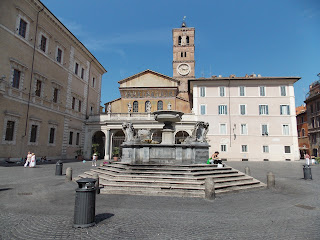Wednesday July 4.
It's the Fourth of July! A holiday of
course at home, and my classmates and I decide to start our day with
an “American” breakfast at When in Rome! Complete with American
flags, and MTV it's a surreal mixture of Roman culture catering to
American tastes. We had a hearty breakfast and started our day.
Today we will visit four churches; St.
Maria, St Cecilia, Passede, and St Maria Maggorie. Due to blog size,
I will write about St Maria of Trastevere and St Cecilia.
Our first stop is St Maria in
Trastevere. St. Maria is surrounded by the Piazza Santa Maria, our
meeting spot each morning. The fountain is a symbol for the belief
that this church is located where a spontaneous fountain of oil began
with the birth of Christ, The church has undergone several
restorations and therefore has artifacts and artwork from many time
periods. The basilica was completely rebuilt in the 12th
century, but dates back to the 3rd century. The mosaic on
the front depicts Madonna and child surrounded by female figures
dressed in royal clothing. As you walk into the church the exterior
walls are covered in pieces of early medieval tombs, showing both
Greek and Latin, along with symbols and Christian messages. Again we
see a basic Basilica design. The massive columns are relics from
other buildings in Rome. The flat ceiling is carved in high relief
and painted in deep blues and gold. The mosaics in the triumphal arch
and dome include Byzantine images of Christ and Madonna sharing the
throne, as emperor and empress and scenes from the life of Mary by
Cavallini. The frescoes are from the late 16th century
showing scenes such as the annunciation and other bible stories begin
to take on a more naturalistic style, rather than the flat
emotionless art of the earlier mosaics. The images were made to help
the poor people understand the stories, even if they could not read.
Our next stop is St Cecilia. Originally
home to the 2nd century Roman noblewoman Cecilia, a patron
of music who converted to Christianity and had a church within her
home. The history of Cecilia shows that when she refused to stop
practicing her religion the Roman empire tried to kill her. The
attempts at scalding her to death were unsuccessful, so she was
beheaded. Even in that attempt however, she remained alive for
several days. It is said that she sang while dying. When the church
was built in the 5th century her body was found,
completely intact in her dying pose. She was removed from the site,
but returned in the 9th century. Her tomb was reopened in
1599 and her body was still intact. It was at that time that the
sculptor Maderno saw the body and created the sculpture that is
placed above her tomb. The sculpture, while beautiful in its design
and masterfully carved, is quite disturbing when you realize that
the head is rotated 180 degrees due to the execution.
This church has
mosaics by Cavallini showing Christ and Mary enthroned, surrounded by
popes and saints. There are frescoes by Cavallini as well, one of
which is at ground level and can be seen up close. In this fresco
depicting the last judgment, we begin to see a modeling of the flesh
tones, and a movement toward realism.





No comments:
Post a Comment